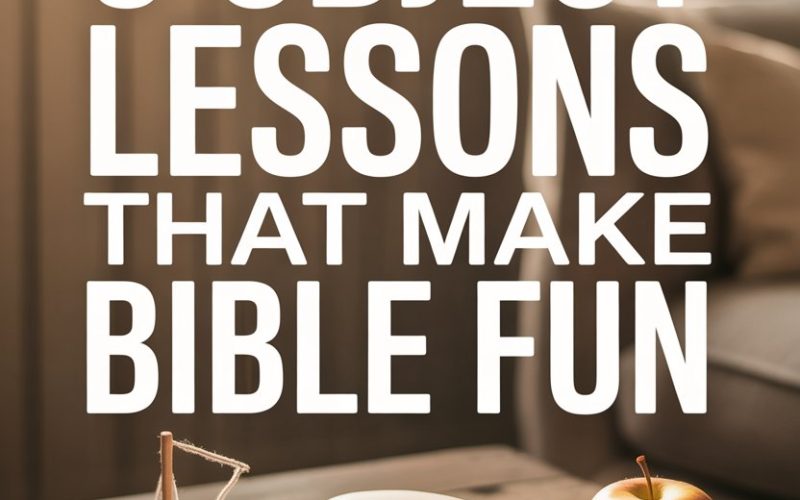Quick confession: “family Bible time” doesn’t always send my kids running to the couch with beatific grins. Sometimes, it’s more of a tactical negotiation involving snacks, cushions, and the odd bribe.
But when we break out simple objects and have a laugh along the way, something special happens—messages stick, conversations start, and yes, everyone actually has fun.
Ready to turn fidgeting into fascination? Here are five tried-and-true object lessons guaranteed to bring the Bible to life for your family.
1. Building on Sand and Rock: The Granola Bar Edition
Jesus may not have used granola bars in the Sermon on the Mount, but he definitely understood how kids think.
The parable about houses built on sand versus rock (Matthew 7:24-27) is basically one big game of “Will it Collapse?”
Grab a baking tray, a packet of cheap biscuits, and a granola bar or two. On one side, pile up some crumbled biscuits (your ‘sand’), and on the other, plop down a sturdy granola bar (‘rock’).
Ask your kids to stack LEGO bricks or wooden blocks on each base. The sand will shift and collapse, while the granola bar stands tall.
Cue the collective gasp, followed by the inevitable “Can I eat the granola bar now?”
That’s your moment: chat about how making wise choices (like being kind instead of snarky, or telling the truth when fibbing would be easier) gives their lives a solid base.
Not only is this hands-on, but it’s also snackable—proof that theology and munchies play well together.
(Pro tip: Don’t let the dog eat the sand pile. Learned that one for you.)
2. The Sin Cleaner: Pennies and Vinegar Shenanigans
Telling a child they “need forgiveness” can land like a wet sock—especially if they’ve just been caught coloring on the wall. Yet, give them a grimy penny and a little science magic, and suddenly you’re in the forgiveness business.
Start with a handful of tarnished coins and a small bowl of vinegar (add a shake of salt for extra sparkle).
Hand the dirty coins to your kids and ask if they can scrub them clean with a dry cloth—spoiler alert: no dice. Now, drop those pennies in the vinegar and watch them shine.
Explain that just like the penny, sometimes hearts get a little grimy (cue giggles and relatable stories about fibs told to siblings). Just scrubbing harder doesn’t work; it takes something special.
In the Bible, that’s forgiveness—no shame, just a fresh start.
Kids will beg to do it again, and you just won “cool parent” points. (Just don’t try this on your wedding ring. Ask me how I know.)
3. The Mustard Seed Mystery: Tiny Faith, Big Moves
Anyone who’s ever swept under the sofa knows the power of something tiny. Jesus said, “faith as small as a mustard seed” can move mountains (Matthew 17:20).
But if you’ve never seen a mustard seed, the metaphor is about as exciting as watching dust settle.
Order a spice jar of mustard seeds or borrow a pinch from the neighbor who bakes. Pour a few onto your child’s palm and ask if they think these could become towering plants. Cue the disbelief.
Next, show a photo or video of a sprawling mustard plant (the Royal Horticultural Society has some great ones), and watch their eyes widen.
Chat about times when something small (a quick “sorry,” a tiny act of kindness, a bedtime prayer) made a surprising difference.
Faith doesn’t have to be big and flashy to matter—sometimes, it’s the little seeds that surprise us the most.
And yes, you’re allowed to joke about not sneezing and scattering mustard seeds into next week’s laundry.
4. Unseen Air: The Invisible Power of Prayer
Air: can’t see it, can’t live without it, can’t get a six-year-old to stop blowing raspberries with it. When it comes to explaining the invisible power of prayer or the Holy Spirit, this lesson is a crowd-pleaser.
Hand each child a balloon and ask them to describe what’s inside (pro tip: “my brother’s hot air” is a common answer).
Encourage them to blow up their balloons, tie them off, and let them go. Cue airborne chaos and delighted shrieks.
Point out that even though you can’t see air, it’s what made the balloons soar—and the room fill with giggles. In the same way, prayer connects us with God, even if we can’t see him.
The results? Sometimes joy, sometimes comfort, sometimes just a sense that we’re not alone.
Kids love thinking about invisible things making a visible difference. Plus, you just made “family devotion” the highlight of the evening—balloon scraps and all.
5. The Light in the Dark: Torch Tag
If you’ve ever had a power outage at bedtime, you know the transformative magic of a torch. Suddenly, every shadow is a monster—or an adventure.
Harness that thrill for a lesson on Jesus as the “light of the world” (John 8:12).
Wait until dusk, then switch off the lights and hand out torches (flashlights, for those who’ve crossed the pond). Challenge your kids to find objects around the room or complete a mini scavenger hunt, but only using the light.
After the giggles and wild shadows settle, have a quick chat: when things feel scary or confusing, even a little light makes a big difference.
Ask them to imagine what it’s like to walk through life without light—cue solemn faces and dramatic torch under-chin poses.
This simple activity sticks, especially when bedtime monsters reappear. You’ll get bonus hugs, and maybe even a heartfelt, “Can we do torch tag again tomorrow?”
Keeping It Simple, Keeping It Sacred
You don’t need craft-store supplies or Pinterest-perfect plans to bring the Bible to life at home. A bit of curiosity, the odd pantry item, and a willingness to laugh at the mess go a long way.
Object lessons don’t just teach—they create memories. Kids are far more likely to recall the time vinegar fizzed or the torch illuminated a toy dinosaur than a stern lecture.
And those moments, small as they seem, are the seeds of lifelong faith.
Here’s the best part: you’ll start noticing the lessons, too. Maybe you’ll spot the “sand and rock” moment on the school run, or remember the invisible power of prayer during a tough morning.
Family faith doesn’t have to look polished. If snack crumbs, giggles, and a few tarnished pennies make your house feel sacred, you’re right on track.
And if all else fails, remember: as long as someone asks, “Can we do that again?”—you’re winning.





